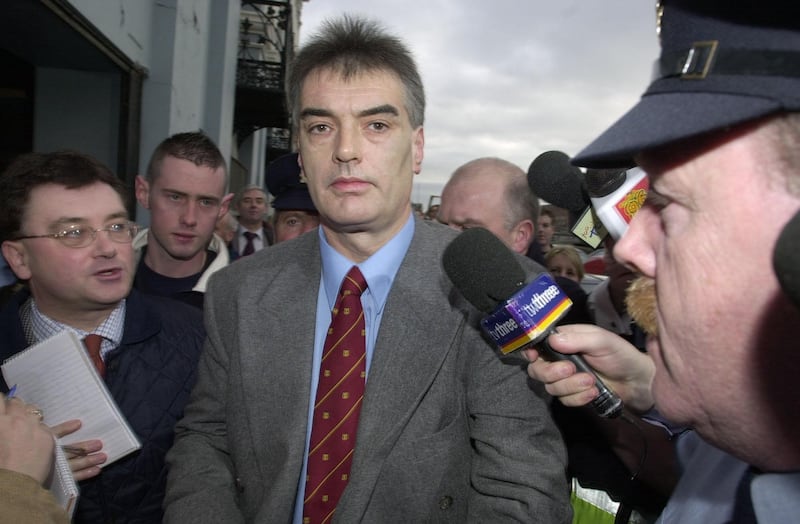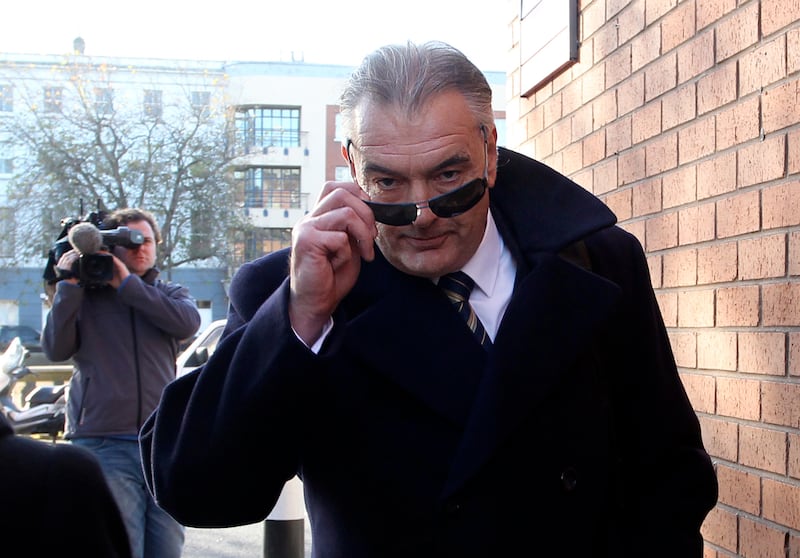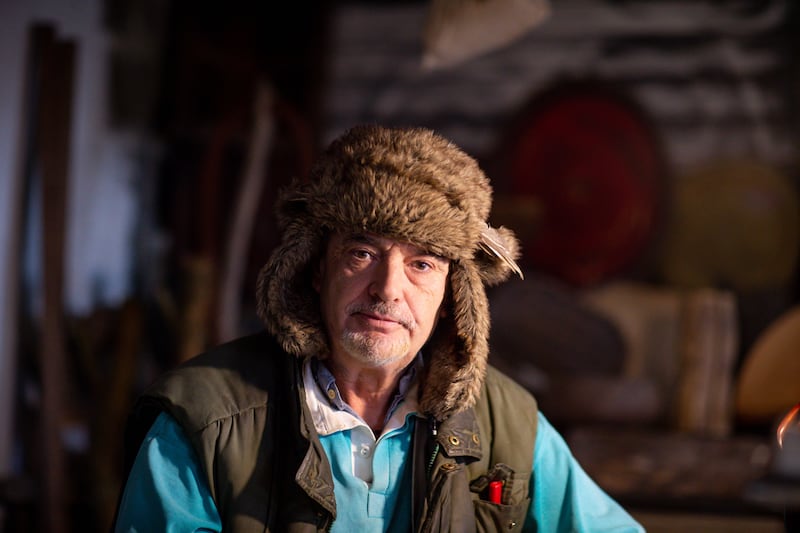Born January 27th, 1957
Died January 21st, 2024
The sudden death last Sunday of Ian Bailey at the age of 66 closed a chapter in what was arguably Ireland’s most notorious unsolved murder – that of Sophie Toscan du Plantier.
Bailey, through his forceful personality and constant craving of attention, managed to produce widely divergent reactions – some saw him as the victim of a grave injustice while to others he was a violent, misogynistic narcissist who revelled in the role of victim.
RM Block
Only last month Bailey portrayed himself as the victim of a miscarriage of justice that was every bit as heinous as the wrong done to the Birmingham Six and the Guildford Four – the people wrongly convicted of IRA bombings in the 1970s. His lawyer, Frank Buttimer, said he believed Bailey had been the victim of a persecution by the Irish State that had contributed to his death.
For others, Bailey was a calculating individual whose willingness to portray himself as the wronged party was the ultimate affront to the family of the French film producer and 39-year-old mother of one, with whose death his name will be forever linked.
Bailey was born, in his own words, “in St Mary’s Hospital, Manchester, England, on a cold January night in 1957″ to butcher Ken Bailey and his Welsh-born wife, Brenda. The family were living in Stockport when a daughter, Kay, was born when Ian was five.
Ken sold his shop to chain operators Dewhurst Butchers, and the family moved around England in the mid-1960s as he trained apprentice butchers for the company. They settled in Hucclecote near Gloucester, where the young Ian attended the Crypt school.
He was a keen sportsman – playing tennis, basketball, cricket and rugby, earning himself a trial for the England under-19 rugby team – and a voracious reader. A chance encounter with a reporter from the News of the World on a family holiday in Jersey planted the idea of journalism as a career.

He later described how he was inspired into journalism by the story of Carl Bernstein and Bob Woodward breaking the Watergate scandal. While at school, he made it to the front page of the Gloucester Citizen with a tale of how the local fire brigade was called to the Crypt school to deal with a swarm of bees.
He got a job as a trainee reporter with local freelance journalist John Hawkins, who ran an agency supplying national papers. It was while working as an apprentice there that he met Sarah Limbrick. The couple married in 1979, but were later divorced.
“It was while training that I met another young journalist, Sarah, and I fell for her and she fell for me and we married subsequently, but I think both of us were far too young to settle down, and the marriage lasted only three or four years – fortunately there were no children,” he later said.
While freelancing in the 1980s, Bailey contributed to the Sunday Times Insight Team in its coverage of a spying scandal at GCHQ in Cheltenham. But, growing disillusioned with journalism, he moved to Ireland in 1991, having previously visited west Cork in 1986.
He met the Welsh artist Jules Thomas while working in a fish factory in Schull. After he rented a room from her at a second house she owned, they began a relationship. He moved in with her and her three daughters at her home at the Prairie, Liscaha, in Schull.
The decision to settle in Schull was to prove fateful. After initially reporting as a journalist on the murder of Sophie Toscan du Plantier at her isolated holiday home at Dreenane, Toormore, on December 23rd, 1996, Bailey later found himself cast in another role – that of prime suspect.
Arrested by gardaí for questioning in February 1997 but released without charge, Bailey took the unusual step of inviting the media in for tea and scones. He gave them his version of his arrest, denied the murder charge – and embarked on a long courtship of the media.

Another arrest and release followed in January 1998. There followed a series of much longer-lasting entanglements with the legal system. He took a libel action against seven newspaper publishers in 2003, when he found himself filleted in the witness box by the newspapers’ counsel, Paul Gallagher.
The public already knew about Bailey’s volcanic temper and violent nature from a 2001 court case which had resulted in a three-month suspended sentence for assaulting Thomas, but the libel case revealed details of assaults in 1993 and in 1996, which Bailey said were to his “eternal shame”.
A former friend, Peter Bielecki, described Thomas’s injuries in 1996 after he found her “curled up in a foetal position at the foot of the bed”. She was,making animal-like sounds, Bielecki said, and had clumps of her hair torn out, bite marks on her hands, scratches and bruises to her face, and a swollen eye.
Dismissing seven of Bailey’s claims against nine titles, Judge Patrick Moran said he was satisfied from the evidence that Bailey was “a violent man” before observing that he was “a man who likes a certain amount of notoriety, that likes perhaps the limelight, that he likes a bit of self-publicity”.
[ ‘I feel nothing, he isn’t in my thoughts’: Jules Thomas on the late Ian BaileyOpens in new window ]
Bailey’s career in journalism had more or less evaporated after he was arrested for questioning about the murder, but he graduated with an honours law degree from UCC in 2013 before going on to complete a master’s with the thesis Policing the Police: Garda Accountability in Ireland.
By then he was already facing another challenge. The French authorities applied for his extradition to France, to be charged there under a provision of the Napoleonic Code, which allows France to prosecute anyone who may have committed a crime against a French citizen overseas.
He was arrested at his home in Schull on April 23rd, 2010, and taken to the High Court, where Mr Justice Michael Peart endorsed a European Arrest Warrant. He and his legal team appealed the extradition to the Supreme Court and won.
Perhaps buoyed by that victory, Bailey launched a civil action against the State for wrongful arrest and conspiracy to frame him for the murder, but after a 64-day trial at the High Court in Dublin, a jury dismissed his claim.
Another French extradition attempt failed but in 2019, Bailey was tried in Paris in absentia, convicted of the voluntary homicide of Toscan du Plantier and sentenced to 25 years in jail – only for another French attempt to have him extradited to serve the sentence fail again.

Bailey split from Thomas in 2021 and lived alone in rented flats in Glengarriff and Bantry, occupying himself by continuing to write poems to add to his two self-published collections, The West Cork Way and A John Wayne State of Mind.
Poet John Montague once read some of Bailey’s poems and said he felt he lacked the discipline to be a proper poet. In 2017 Bailey launched The West Cork Way at Electric Picnic, where he read a poem that included the line, “A thousand arrows they fired at him yet failed to kill the poet within”.
Proudly proclaiming himself a “Twitter virgin”, Bailey took with gusto to social media in 2021, posting regularly to his 5,000 of what he called his “friends, fans and followers” as he shared poems and updates on the murder investigation, in between angry exchanges with those whom he described as “trolls harassing me” and comments on photographs of young women.
Ever the egotist, his behaviour in July 2018 when West Cork podcast producers Sam Bungey and Jennifer Forde were interviewed by now Irish Times columnist Justine McCarthy in the Maritime Hotel in Bantry as part of the West Cork Literary Festival highlighted that he wasn’t averse to the attention he attracted. Dressed in a cream suit and a flamboyant fedora, Bailey and his then partner, Jules Thomas, arrived at 7.45pm and sat near the door and over the next 15 minutes, he left and re-entered the room six times – by which time there wasn’t a person in the 500-strong audience who hadn’t seen him.
Perhaps it was seeing how both the podcast – and TV documentaries by Jim Sheridan and Netflix on the murder – garnered huge audiences that led him to make his own three-part podcast, Ian Bailey in His Own Words, telling his life story and protesting his innocence yet again of the murder.
A looming figure at Skibbereen and Schull markets, where he sold his poems and pizza, he seemed to enjoy his notoriety, posing for selfies with visitors and declaring after the TV documentaries that the ATMs in Schull had run out of cash because of “murder tourists wanting to see me and visit the crime scene”.
A keen gardener and wildlife watcher, he was a curious cultural mix, expressing admiration for Winston Churchill and Michael Collins, speaking pidgin Irish and learning to play the bodhrán (one wit said of his playing, “Bailey and his bodhrán could clear a pub faster than a fire alarm”).
Described by Jules Thomas as “a creature of excess”, Bailey smoked cannabis – he was appealing a drug-driving conviction at the time of his death – and was a heavy drinker from the age of 20.
Following his death, Frank Buttimer described him as “resilient”, and few would dispute that as he remained positive in the face of every setback, something he attributed to meditation and his daily reciting of the serenity prayer: “God grant me the serenity to accept the things I cannot change, courage to change the things I can, and wisdom to know the difference.”
Ian Bailey is predeceased by his parents, Kenneth and Brenda, and survived by his sister, Kay Reynolds.
















